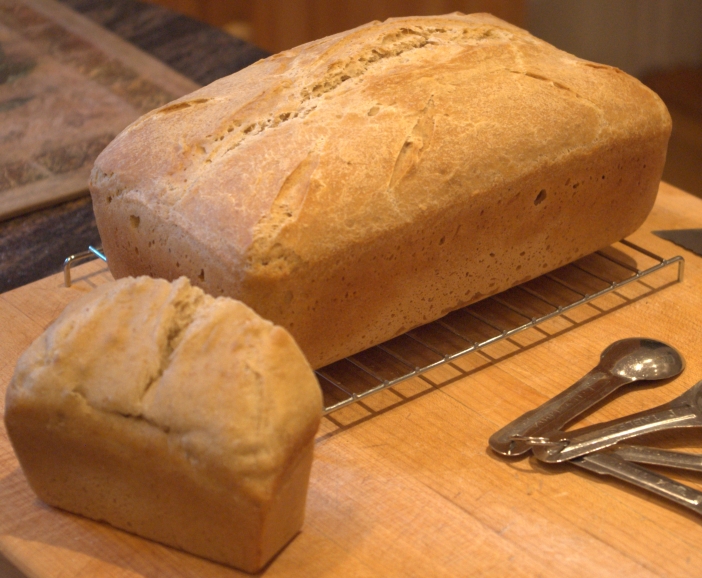Greetings -
After a couple of years' hiatus, it appears that I'm (getting) back on the sourdough treadmill.
(The sourdough starter in question is my home-grown, Brookline-based starter.)
Today's loaf is shown below (behind the remnants of last week's undercooked (but wonderful toasted) loaf):

After filling the pan about half full, I got (I think) a reasonable (single) rise,
which took 3-4 hours (which took it to the top of the pan), and another inch
or so with the oven spring (a 500 degree F oven, reduced immediately to 400,
for 35-40 minutes):

Here's the crumb:

It tastes delicious.
My question - should I be trying a second rise? My experience has been that the dough
starts to get awfully 'fragile' after 3 hours, starting to disintegrate. I'm wondering --
if I flipped it halfway through, might I get more uniform crumb? (One can see from the
image above that the top half of the loaf is 'airier' than the bottom half).
Or is that more trouble than it's worth?
And any thoughts on how might I avoid that dip in the middle at the sides of the loaf?
Insight welcome.
Thanks,
- Richard
A healthy, stable starter should be able to handle two rises with no problem. This leads me to wonder how you are feeding and preparing your starter prior to the dough mix. If your starter is not healthy it may be too acidic, which can cause gluten break down. Your bread looks like that could, indeed, be the problem. Do you discard most of your old starter before feeding? You should only save a spoonful or two. How often do you feed, and how much?
I actually try to keep (or use) most of my starter. I keep a 'dry' starter
(somewhere between 2 & 3 parts flour to 1 part water), and feed
every 36-48 hours, which gives me a couple of loaves each a week.
How does one modify the starter feeding to make it less acidic?
FWIW, I keep the starter at room temperature, unless I'm going on vacation
(in which case it goes into the fridge).
If you want your starter to be less acidic, you want to do a few things:
Feed more often. 24 hours will produce a good bread. 12 hours even better and likely optimal for sour flavor, in my experience. The shorter time between feedings gives the yeast the time it needs to get to work without giving the acid-producing bacteria the time that they need to really get cranking. You can take the time down to 8 or even 4 hours between feedings if you want to eliminate sourness altogether, and this is used in some traditional French and Italian breads I guess.
Keep your starter dry. I've actually had pretty mixed results with this. When I keep my starter dry it stays relatively plain, but the moment I increase the hydration the acidity really kicks in. I actually used this to increase the acidity of my starter when it was younger and weaker.
Discard more starter. If you're not baking, you only need to keep a very small amount of starter on hand. 50g of even a fairly weak starter can be built up to the amounts you need for a big bake in a day or two if you take it slow. Even at such a small nugget, you wind up with a lot of discards. If you have an aversion to waste, keep the discard in a separate container and make sourdough pancakes, waffles or english muffins.
Keeping the starter in the refrigerator does not really reduce the acidity but it does drastically reduce the amount you need to feed your starter. You can safely go a week between feedings if you feed and then refrigerate. I've left my starter for 3 weeks between feedings and it came back just fine.
Hope this helped a little.